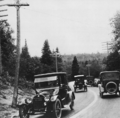Michigan Highways
The State Trunkline Highway System of the US state of Michigan is a network of roads owned and maintained by the Michigan Department of Transportation (MDOT). The most prominent of these roads are part of one of three numbered highway systems in Michigan: Interstates Highways, US Highways, and the other State Trunklines. Other systems of roads are operated by the 83 counties in the state as well as each city.


Interstate Highways and US Highways are assigned at the national level. Interstate Highways are numbered in a grid—even-numbered highways are east–west highways (with the lowest numbers along Mexico and the Gulf of Mexico), and odd-numbered highways are north–south highways (with the lowest numbers along the Pacific Ocean). US Highways are also numbered in a grid—even numbered for east–west highways (with the lowest numbers along Canada) and odd numbered for north–south highways (with the lowest numbers along the Atlantic Ocean). For this reason, mainline (two-digit) Interstate Highways in Michigan all have numbers above 69 and mainline US Highways all have numbers below 45. Three-digit Interstate and U.S. Highways, also known as "child routes," are branches off their main one- or two-digit "parents". The Interstate and US Highways are maintained by MDOT. Interstate 75 (I-75) and US Highway 23 (US 23) are the longest examples in the state.


State Trunklines are the other state highways maintained by MDOT. These highways are completely owned and maintained by the state. Michigan highways are properly referred to using the M and never as "Route 28" or "Highway 115", but as M-28 or M-115. The marker used for state trunklines is a diamond with a block-letter "M" at the top. Roads that are maintained by the state but not assigned a state trunkline designation carry an unsigned highway designation.


County-Designated Highways are assigned numbers in a zone system by MDOT, but maintained by the counties. Each zone is indicated by a letter A–H which is followed by a number based on a grid inside that zone. Each county also maintains any other roadway that is not a state trunkline or a city street. The numbering and signing practices vary from county to county, as does the size of each county's system. Numerical designations typically do not carry over from one county to the next; a CDH that crosses county lines keeps its designation in each county however. County road designations are typically abbreviated "CR" or "Co Rd" followed by the number, and CDHs are abbreviated to just their letter and number assignment.
Interstate 96 (I-96) is an east–west Interstate Highway that runs for approximately 192 miles (309 km) entirely within the Lower Peninsula of the US state of Michigan. The western terminus is at an interchange with US Highway 31 (US 31) and Business US 31 (Bus. US 31) on the eastern boundary of Norton Shores southeast of Muskegon, and the eastern terminus is at I-75 near the Ambassador Bridge in Detroit. From Grand Rapids through Lansing to Detroit, the freeway parallels Grand River Avenue, never straying more than a few miles from the decommissioned US 16. The Wayne County section of I-96 is named the Jeffries Freeway from its eastern terminus to the junction with I-275 and M-14. Though maps still refer to the freeway as the Jeffries, the portion within the city of Detroit was renamed by the state legislature as the Rosa Parks Memorial Highway in December 2005 in honor of the late civil rights pioneer. There are four auxiliary Interstates as well as two current and four former business routes associated with I-96.
Grand River Avenue originated as an Indian trail before Michigan statehood. It later was used as a wagon road across the state. The roadway was included in the State Trunkline Highway System in 1919 as M-16 and later the United States Numbered Highway System as US 16. Construction of a freeway along the length of the corridor was proposed in the 1940s, and included as part of the Interstate Highway System in the mid-1950s. This construction was started in 1956 and initially completed across the state to Detroit in 1962. The proposed route for the Jeffries Freeway in Detroit was moved in the 1960s; it was built in the 1970s. I-96 was completed on November 21, 1977, in the Detroit area, closing the last gap along the route. Since then, additional interchanges and lanes have been added in places to accommodate traffic needs. (Full article...)
General images
Selected picture
Topics
State Trunkline System, overview of the system
- Interstates Highways in the state
- US Highways in the state
- State Trunklines
- County-Designated Highways in the state
- Pure Michigan Byways, a system of scenic, historical or recreational highways in the state
- Great Lakes Circle Tour
Subcategories
Related portals
WikiProjects
Things to do
Nominations and votes for selected articles and selected pictures are always needed. Anyone can nominate an article, and anyone can vote for an article. You can also recommend items for Did you know?. Improvements to the articles are always welcome as the project works on expanding and nominating the remaining ones for Good Article or Featured Article status.





























